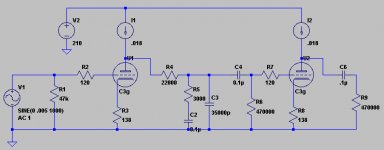Hey all.
I'm currently "designing" an all C3g phono stage, and this is what I've cobbled together from various sources I've come across. It's somewhat similar to audiodesignguides phono4, but using ccs loaded C3gs. I was thinking about using CCS loaded d3a's, but figured the gain would be far to much.
(I liked the transformer coupled design too, but figured $$$ ...)
The C3g will be sitting at about 180V, biased at 18ma (seemed a nice, arbitary point, but I'm not married to it).
As I've calculated, this would give me about 44db gain (0.005V input, 0.8V output), which may be a tad much, but I could easily tweak the rest of my setup to match.
Any advice/suggestions to improve it ?
I am kind of attached to the idea of using the C3g's (at least for the input tube).
I'm currently "designing" an all C3g phono stage, and this is what I've cobbled together from various sources I've come across. It's somewhat similar to audiodesignguides phono4, but using ccs loaded C3gs. I was thinking about using CCS loaded d3a's, but figured the gain would be far to much.
(I liked the transformer coupled design too, but figured $$$ ...)
The C3g will be sitting at about 180V, biased at 18ma (seemed a nice, arbitary point, but I'm not married to it).
As I've calculated, this would give me about 44db gain (0.005V input, 0.8V output), which may be a tad much, but I could easily tweak the rest of my setup to match.
Any advice/suggestions to improve it ?
I am kind of attached to the idea of using the C3g's (at least for the input tube).
Attachments
Hi,
Well, triode wired the C3g is just a 417A kind triode, not bad, by any notes.
But why not make the first stage a Pentode?
As a pentode has a very high output impedance (think current source) you can use the RIAA EQ Network as anode load, so the common headroom penalties etc. from passive EQ disappear, despite the EQ being still passive.
Who knows, using the second stage also as Pentode with a low Anode load might sound very good.
Somehow I like to use German pentodes as such, where possible. Many old German pro audio preamplifiers use the combo of pentode input and triode wired pentode output and because of their outstanding sound quality are quite sought after.
Ciao T
Any advice/suggestions to improve it ?
Well, triode wired the C3g is just a 417A kind triode, not bad, by any notes.
But why not make the first stage a Pentode?
As a pentode has a very high output impedance (think current source) you can use the RIAA EQ Network as anode load, so the common headroom penalties etc. from passive EQ disappear, despite the EQ being still passive.
Who knows, using the second stage also as Pentode with a low Anode load might sound very good.
Somehow I like to use German pentodes as such, where possible. Many old German pro audio preamplifiers use the combo of pentode input and triode wired pentode output and because of their outstanding sound quality are quite sought after.
Ciao T
By using RIAA network as the anode load, do you mean using the 22k resistor as the load (rather than the CCS), and omitting it from the network ?
Though wouldn't using the pentode in pentode mode 🙂P) increase the gain quite a bit ? Though, from my (very limited) understanding of pentodes, I should be able to adjust the gain via the anode resistor, then recalculate the RIAA from there ...
... or something.
Though wouldn't using the pentode in pentode mode 🙂P) increase the gain quite a bit ? Though, from my (very limited) understanding of pentodes, I should be able to adjust the gain via the anode resistor, then recalculate the RIAA from there ...
... or something.
Hi,
No, I mean using the anode load as the series resistor, with the other RC circuit parts to ground or +B. So the anode load is essentially frequency dependent and performs the equalisation by varying the load with frequency.
Depends. The C3g is listed as 14mA/V transocnuctance. With a 10K anode load at low frequencies the gain would be 140. As the impedance of the anode load reduces by a factor 10 in the midrange the gain would be around 14. The second stage can then have very low gain.
Ciao T
By using RIAA network as the anode load, do you mean using the 22k resistor as the load (rather than the CCS), and omitting it from the network ?
No, I mean using the anode load as the series resistor, with the other RC circuit parts to ground or +B. So the anode load is essentially frequency dependent and performs the equalisation by varying the load with frequency.
Though wouldn't using the pentode in pentode mode 🙂P) increase the gain quite a bit ?
Depends. The C3g is listed as 14mA/V transocnuctance. With a 10K anode load at low frequencies the gain would be 140. As the impedance of the anode load reduces by a factor 10 in the midrange the gain would be around 14. The second stage can then have very low gain.
Ciao T
- Status
- Not open for further replies.
